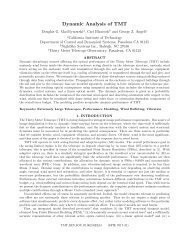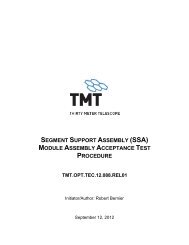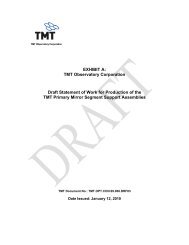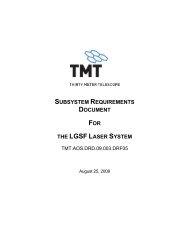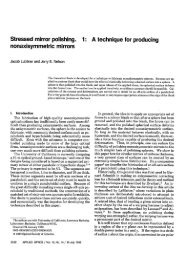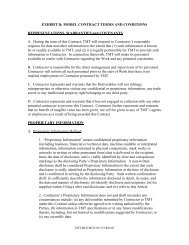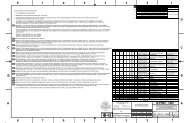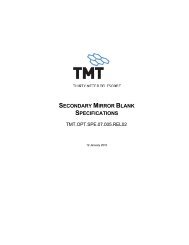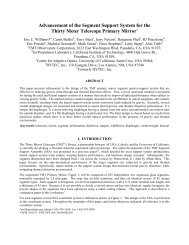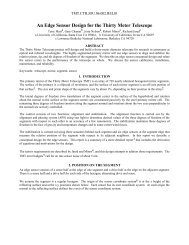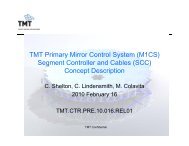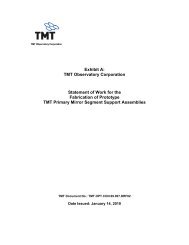TMT Construction Proposal - Thirty Meter Telescope
TMT Construction Proposal - Thirty Meter Telescope
TMT Construction Proposal - Thirty Meter Telescope
You also want an ePaper? Increase the reach of your titles
YUMPU automatically turns print PDFs into web optimized ePapers that Google loves.
To the extent consistent with these shielding requirements, the enclosure should allow natural air venting of the<br />
primary mirror to reduce M1 seeing.<br />
To minimize thermal differences that will degrade image quality, the enclosure interior should be cooled during<br />
the day so the telescope is at the expected night-time temperature.<br />
3.5 Adaptive Optics<br />
Diffraction-limited observations are a key capability of <strong>TMT</strong>, and this will be delivered by the AO system. Ideally<br />
we would like to make diffraction-limited observations over the entire sky and for all wavelengths. Our<br />
understanding of the technology suggests this will not be available in the foreseeable future, so we have made<br />
some compromises in the required early AO capability.<br />
We will eventually want an AO system that can deliver rms wavefront errors of ~ 130 nm with full sky coverage,<br />
corresponding to a Strehl ratio of 0.5 at 1µm. For a range of cost, schedule, and technical considerations, we<br />
will accept a first-light AO capability with 187-191 nm rms wavefront error over a 10 arcsec field of view. This<br />
corresponds to a Strehl of 0.5 at 1.36µm. The AO system must deliver this performance over a majority of the<br />
sky (e.g. 50% sky coverage at the galactic pole). This sky coverage is expected to be achieved with a multiple<br />
laser beacon system. A subsequent upgrade will reduce the AO system noise to 130 nm.<br />
We anticipate several valuable modes of AO:<br />
Narrow-Field, Diffraction-limited, Near IR, or narrow Field IR Adaptive Optics System (NFIRAOS) will be used<br />
for NIR spectroscopy and can feed an on-axis integral field unit (IFU) and sample the image at the diffraction<br />
limit. A small field is sufficient (10 arcsec) as long as we have close to 50% sky coverage. Image motion will<br />
degrade image size over a higher fraction of the sky. Again, we expect that a Laser Guide Star system will be<br />
needed to achieve this sky coverage. NIFIRAOS is a MCAO system with conjugates at 0 and 12km.<br />
NFIRAOS is expected to deliver much improved image quality over a 2 arcmin field of view that will be used by<br />
an infrared multislit spectrometer. Expected AO performance over a 30 arcsec FoV and a 2 arcmin field are<br />
given in Table 3-1.. The LGS tomography is optimized for each FoV.<br />
Wide Field, Near-Diffraction-Limited, or multiple object adaptive optics (MOAO) will involve making AO<br />
correction of a number of small discrete angular regions (1-5 arcsec) distributed throughout a 5 arcmin field of<br />
view. This will allow diffraction-limited spectroscopy of 10-20 objects at a time.<br />
Moderate field, Diffraction-Limited, or Multi-conjugate Adaptive Optics (MCAO) which will have a well corrected<br />
30 arcsec field of view to allow precision photometry and imaging at the diffraction limit in the near IR. This role<br />
is initially filled by NFIRAOS.<br />
Small field diffraction-limited mid-IR (MIRAO) is the highest priority mid-IR science (5-28µm). It requires only a<br />
small field of view, as the science instrument will be an echelle spectrometer. High sky coverage is required.<br />
Planet Detection near the parent star will require Extreme Adaptive Optics. A proposed instrument, Planet<br />
Formation Imager will provide the additional AO capabilities and a coronagraph to make high contrast imaging<br />
Table 3-1: Enclosed Energy Fractions using NFIRAOS, inside of selected diameters of 50,<br />
100, 200 mas<br />
Field of view Wavelength band Image at center of field Image at edge of field<br />
50mas 100mas 200mas 50mas 100mas 200mas<br />
30 arcsec J (1.06-1.44µm) 0.60 0.62 0.66 0.58 0.59 0.62<br />
30 arcsec H (1.53-1.83µm) 0.73 0.74 0.78 0.70 0.72 0.76<br />
30 arcsec K (1.96-2.44µm) 0.79 0.80 0.84 0.78 0.79 0.82<br />
120 arcsec J (1.06-1.44µm) 0.30 0.38 0.52 0.15 0.26 0.46<br />
120 arcsec H (1.53-1.83µm) 0.48 0.54 0.63 0.30 0.38 0.57<br />
120 arcsec K (1.96-2.44µm) 0.61 0.66 0.72 0.46 0.51 0.64<br />
possible on relatively bright stars.<br />
<strong>TMT</strong> <strong>Construction</strong> <strong>Proposal</strong> 26



